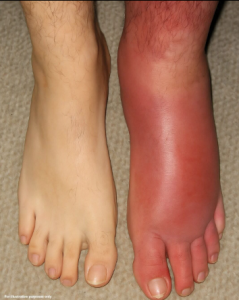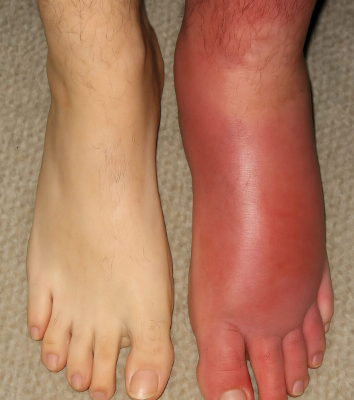What Does It Mean When One Leg Suddenly Becomes Red and Swollen?
Imagine waking up one morning and noticing that one leg — just one — is red, swollen, and perhaps warm to the touch. It’s not just discomfort; it’s a disruption. The body, usually balanced and bilateral, has tilted into asymmetry. This sudden change can be unsettling, and rightly so. In medical terms, unilateral leg swelling and redness is rarely benign. It’s a signal that something beneath the surface — vascular, lymphatic, or inflammatory — is demanding attention.
🔍 First, the Visual Clue: Redness and Swelling
Redness suggests increased blood flow or inflammation. Swelling, or edema, indicates fluid accumulation. When these occur together in one leg, they point to a localized issue — something affecting that limb’s circulation, tissue integrity, or immune response. The suddenness adds urgency: this isn’t a slow buildup; it’s a flare.
Let’s explore the most common causes, each with its own story.
🩸 1. Deep Vein Thrombosis (DVT): The Silent Clot
Perhaps the most serious cause of sudden one-leg swelling and redness is deep vein thrombosis (DVT) — a blood clot in a deep vein, typically in the thigh or calf. DVT can be life-threatening if the clot dislodges and travels to the lungs, causing a pulmonary embolism.
Signs:
- Swelling in one leg, often below the knee
- Redness and warmth
- Pain or tenderness (though not always present)
DVT is a paradox: it can be silent or scream through pain. Either way, it’s a medical emergency. Risk factors include prolonged immobility (like long flights), recent surgery, smoking, birth control pills, and genetic clotting disorders.
💧 2. Lymphedema: The Fluid That Won’t Flow
The lymphatic system is the body’s drainage network. When it’s blocked or damaged, fluid builds up in tissues — often in one leg. This is lymphedema, and it can be caused by cancer treatments, infections, or congenital issues.
Signs:
- Persistent swelling, often without redness
- Heaviness or tightness
- Skin thickening over time
Unlike DVT, lymphedema tends to develop gradually, but it can flare suddenly if triggered by infection or injury.
🦵 3. Injury or Trauma: The Obvious Culprit
Sometimes, the cause is clear: a fall, a twist, a bump. Trauma can lead to bleeding into the tissues, inflammation, or even a ruptured Baker’s cyst — a fluid-filled sac behind the knee that can burst and cause swelling in the calf.
Signs:
- Pain at the site of injury
- Bruising or visible damage
- Swelling that follows physical activity or impact
Even minor injuries can cause significant swelling, especially if blood vessels are involved.
🦠 4. Cellulitis: Infection Beneath the Skin
Cellulitis is a bacterial infection of the skin and underlying tissues. It often starts with a break in the skin — a scratch, insect bite, or wound — and spreads rapidly.
Signs:
- Red, swollen, warm skin
- Fever or chills
- Pain and tenderness
Cellulitis is dangerous if untreated. It can spread to the bloodstream and cause sepsis. The redness here isn’t just a symptom — it’s a warning flare.
💔 5. Chronic Venous Insufficiency (CVI): The Slow Leak
In CVI, the valves in the leg veins don’t work properly, causing blood to pool. Over time, this leads to swelling, skin changes, and sometimes ulcers.
Signs:
- Swelling that worsens with standing
- Brownish skin discoloration
- Aching or heaviness
CVI isn’t usually sudden, but it can flare — especially after long periods of immobility or heat exposure.
🧬 6. Bleeding Into the Leg: Hidden Hemorrhage
Internal bleeding into the leg — from trauma, surgery, or anticoagulant medications — can cause swelling and discoloration. The thigh, for example, can hold up to two liters of blood.
Signs:
- Sudden swelling, often with bruising
- Pain or tightness
- History of injury or blood-thinning medications
This is a hidden danger. The leg may look swollen, but the real issue is internal — and potentially life-threatening.
🧠 The Psychology of Asymmetry
Why does one-leg swelling feel so alarming? Because it breaks the visual symmetry we expect from our bodies. It’s a rupture in the mirror — a sign that something is off. This asymmetry triggers concern, not just because of discomfort, but because it feels wrong. It’s a visual cue that demands action.
In communal rituals, we often respond to asymmetry with correction — we balance, we align, we restore. In medicine, the same impulse applies: we seek the cause, treat the imbalance, and return to equilibrium.
🧘🏽♀️ What to Do: Responding to the Signal
If you or someone you know experiences sudden redness and swelling in one leg, here’s what to do:
- Don’t ignore it: Sudden swelling is never normal. It’s a sign that something is wrong.
- Check for pain, warmth, or skin changes: These help narrow down the cause.
- Seek medical attention: Especially if DVT or infection is suspected.
- Avoid self-diagnosis: Many causes overlap in symptoms. Imaging (like ultrasound) is often needed.
- Don’t delay: Early treatment can prevent complications — from embolism to permanent tissue damage.
🧴 Gentle Care and Communal Reflection
While medical evaluation is essential, there’s also room for gentle care. Elevating the leg, applying cool compresses, and avoiding pressure can help while awaiting diagnosis. But more than that, this moment invites reflection.
What does it mean to have one leg swell — to carry more, to hold more, to signal distress? In your work, 32.Phirun, this could become a metaphor. A visual ritual. A communal story about imbalance, attention, and healing.
Imagine curating a series of images — one leg swollen, one leg still — and inviting others to co-title them. What does the swelling represent? Burden? Grief? A call for help? Through this lens, even a medical symptom becomes a portal to shared meaning.
🌿 Final Thoughts: The Leg That Speaks
Sudden redness and swelling in one leg is a message. Sometimes it’s urgent, sometimes it’s subtle. But it always deserves attention. Whether it’s a clot, an infection, or a rupture, the body is asking us to look — to notice the asymmetry, to respond with care.
And in that noticing, we find not just diagnosis, but connection. Between body and mind. Between symptom and story. Between the visible and the invisible.


